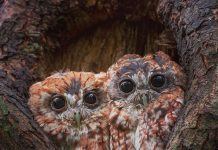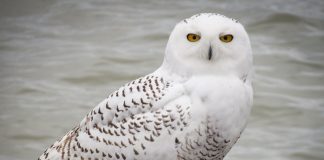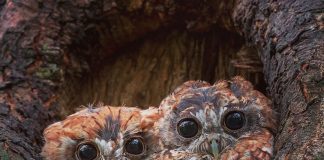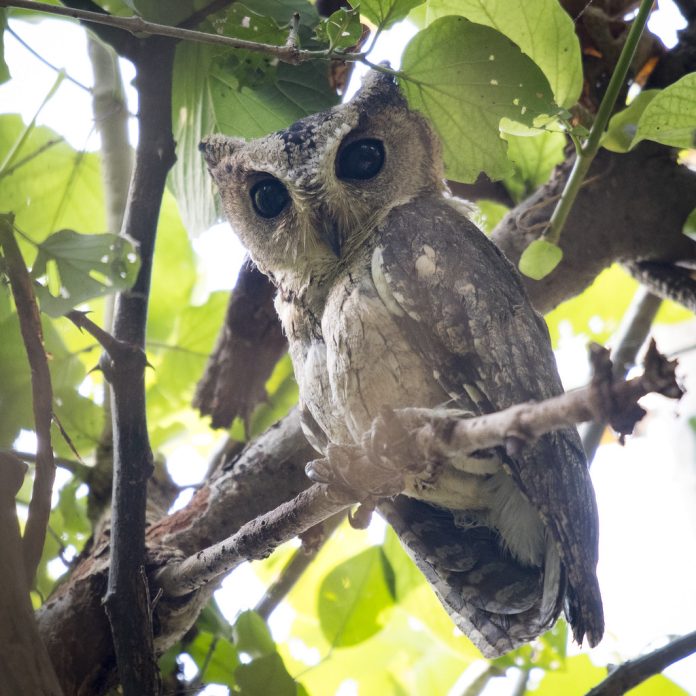
Introducing the Adorable Indian Scops Owl
The Indian scops owl has been a source of fascination for generations. This majestic bird, with its bright yellow eyes and distinct calls, is both an iconic symbol in India and an important part of the ecosystem. But what exactly makes this creature so special?
To explore that question further, let’s take a closer look at some interesting facts about the Indian scops owl. For starters, it is one of Asia’s smallest owls: measuring approximately seven inches from head to tail! Its distinctive facial disc helps amplify sound waves as well as provide camouflage against predators. As if that weren’t enough, its feathers are incredibly soft and fluffy – making them ideal for cushioning long nights spent perched atop tree branches or other perches.
Most importantly, though, the Indian scops owl plays an essential role in the environment by controlling rodent populations. By preying on small mammals such as rats and mice, these beautiful birds help maintain balance in nature while also allowing people to connect with wildlife in their backyards, whether you’re admiring their graceful flight during dusk or simply listening to their haunting call echoing through the night sky, observing these creatures in action is uniquely magical.
Classification of the Indian Scops Owl
- The Indian Scops Owl belongs to the animal kingdom.
- It is part of the chordate subphylum, which includes animals with a notochord.
- It is part of the vertebrate superclass, which includes animals with a backbone.
- It is part of the aves class, which includes birds.
- It is part of the strigiformes order, which includes owls and barn owls.
- It is part of the strigidae family, which includes true owls.
- It is part of the otus genus, which includes scops owls.
- Scientific species name: Otus bakkamoena.
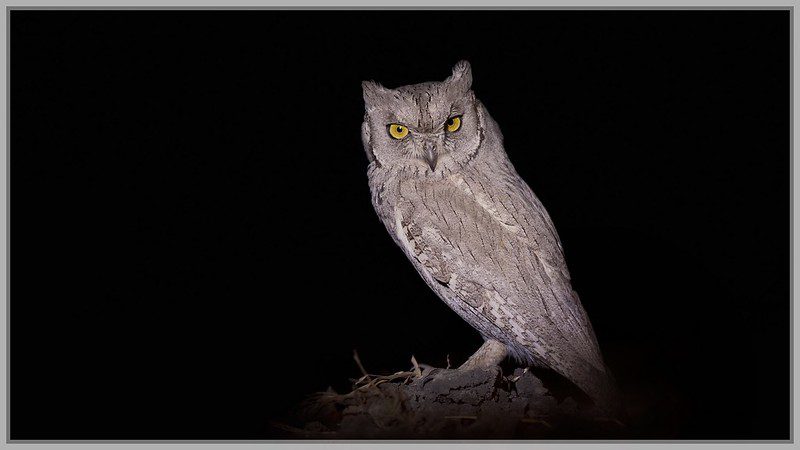
Overview
The Indian scops owl, or Otus bakkamoena, is a species of small scops owl native to India and Southeast Asia. It’s easily identifiable by its distinctive facial disk – white with blackish-brown streaks across the forehead and around the eyes – as well as its brown upper parts and pale underparts. The head also has two tufts that look like ears, giving it a slightly comical appearance.
This little bird inhabits semi-open habitats, including tropical forests, deciduous woodlands, scrub jungles, gardens, and farmlands. Their diet consists mostly of insects such as beetles and grasshoppers, but they’ll take advantage of any available food source, including rodents, frogs, and lizards. They hunt mainly at night when their prey is most active.
In addition to being an entertaining sight in nature reserves, these owls contribute greatly to controlling insect populations in the surrounding agricultural areas, thus providing environmental balance in their respective regions. All things considered, they are important members of the ecosystem – making them worth looking out for!
Habitat And Range
Indian Scops Owl habitat and Distribution Map
The Indian Scops Owl, also known as Otus bakkamoena, is a small species of owl that can be found in many parts of India. Its habitat and range are fascinating to study because they tell us so much about this unique bird.
This scops owl likes open woodlands with trees that provide plenty of natural cover for hunting and nesting. They are often found around the edges of agricultural land or wetlands where there is more food available than in dense forests. This species prefers areas near human settlements but not too close; they need large enough spaces to feel comfortable living in their environment.
When it comes to its range, the Indian Scops Owl has a broad distribution across most regions of India except for some mountainous areas.
Some of these locations include South Pakistan, the northwest Himalayas, India east to western Bengal, the Himalayas from Kashmir east to central Nepal, and south to Sri Lanka.
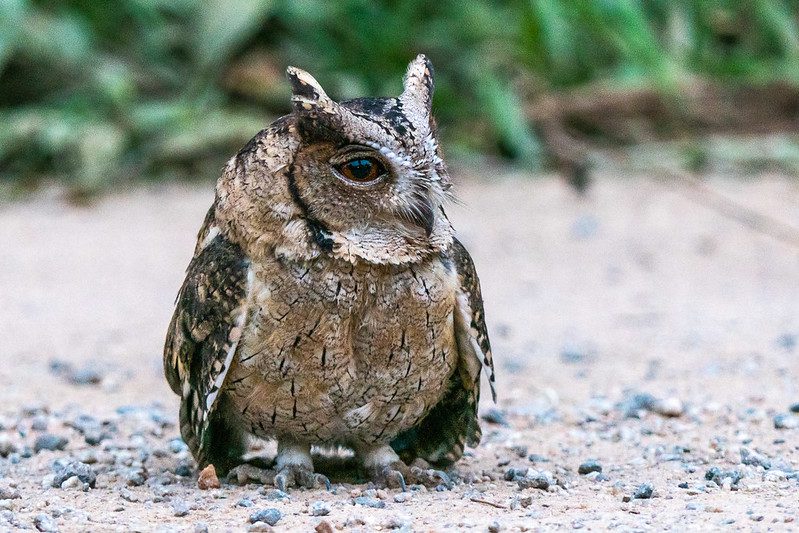
It can be seen from sea level up to elevations over 6500 feet (2000 meters). Their range extends eastward into Nepal and Bangladesh and northwards towards Pakistan, giving them an incredibly wide area of habitation throughout these countries.
No matter what part of India you visit, chances are you will find at least one Indian Scops Owl nearby – making it a great example of how animals adapt to different habitats while remaining true to their own nature!
Description
Leaving the habitat and range of the Indian Scops Owl behind, we now turn to its description. This species is a small owl with a round head and yellow eyes. Its facial disk is brownish-grey in color and has white spots near the beak as well as on the sides of its face. It also has mottled feathers that are grayish-brown above and whitish below. The wings are broad and rounded, making them capable of both quick flights for hunting or gliding for long distances when migrating.
The Indian Scops Owl is distinctive among other owls due to its call, which sounds like “kee-ow” repeated over several seconds until fading away into silence. During the breeding season, males will often hoot in duets back and forth to one another in order to attract mates. They may even produce a separate call at dusk that sounds like “kwaark kwaark kwaark” followed by a loud chuckle sound produced in their throat while they puff up their feathers slightly.
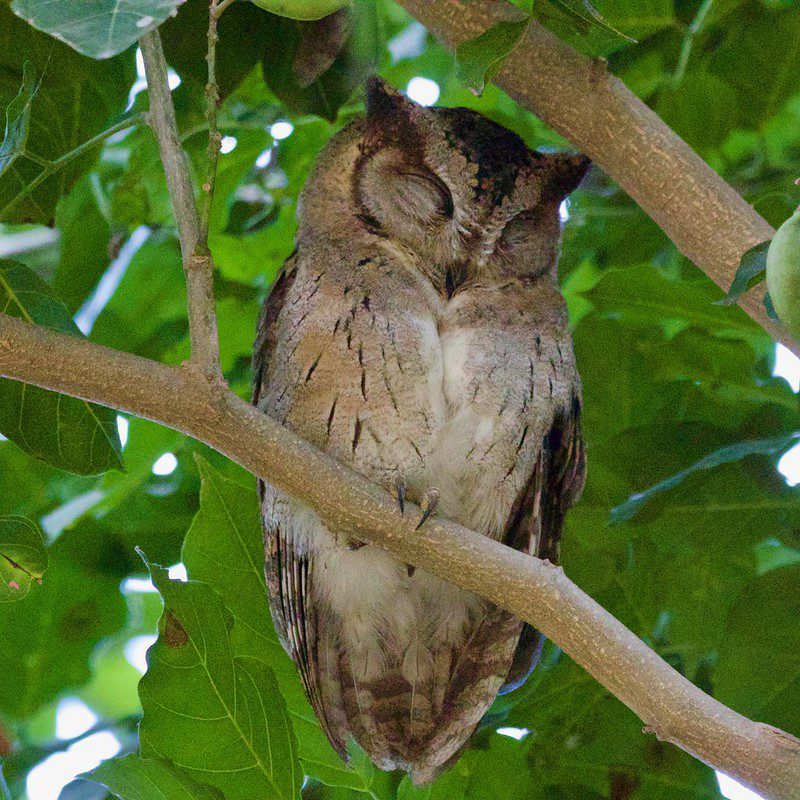
When perched, this species can appear rather plain due to its camouflaged plumage; however, upon closer inspection, you may find yourself entranced by its fascinating beauty – from an intricately patterned body to bright yellow eyes that seem almost wise beyond reckoning! All these qualities make the Indian Scops Owl an incredible creature worthy of admiration and respect.
Diet And Feeding Habits
The Indian scops owl has a diverse diet and varied feeding habits. Its preferred prey includes small insects such as beetles, moths, crickets, and grasshoppers. It will also feed on smaller vertebrates like mice, frogs, lizards, and snakes, and the occasional bird egg or fledgling. This adaptable little predator can easily find food no matter what its environment might be like.
When hunting for prey, the Indian scops owl uses a combination of watching from perches in trees or bushes while scanning the ground with its keen eyesight. When it identifies potential food sources, it swoops down to seize them with its powerful talons. After catching their target, they usually take it back up into a tree where they can consume it more safely away from other predators.
As part of their nightly routine, these owls often travel long distances in search of food, giving them even greater access to an abundant source of sustenance. The diet of this species is incredibly flexible due to both their wide range of habitat types and their willingness to hunt during the day or night, depending upon availability and need. With so many options available to them, these agile hunters don’t have much difficulty finding something delicious to eat!
Indian Scops Owl Call
The Indian Scops Owl has a distinctive call that is often described as a soft, monotonous, and rhythmic “poop-poop-poop” or “whoo-whoo-whoo” sound.
The male and female Indian Scops Owls have slightly different calls, with the male’s call being higher-pitched and faster than the female’s.
The Indian Scops Owl is mostly nocturnal, and its call is usually heard at night, especially during breeding season from March to August.
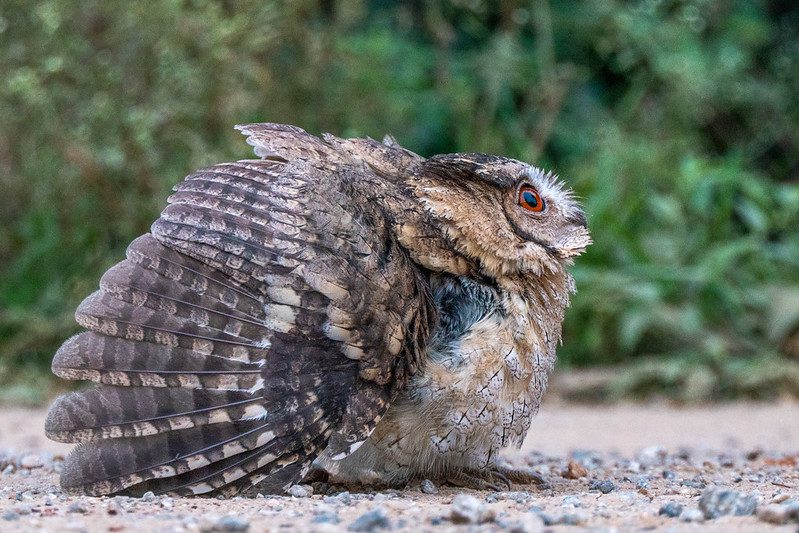
Reproduction And Lifespan
The Indian Scops Owl is a magnificent and mysterious creature with a distinct call often heard at night. But how does this species reproduce and live? Let’s take a closer look at their breeding behavior and life expectancy.
When it comes to reproduction, the Indian Scops Owl typically breeds between April and August. They are monogamous birds that mate for life, so they will usually return to the same nest each year. The nest sites are located high up in trees, usually near water sources or sparsely wooded areas.
The female scops owl lays around three eggs per clutch, hatching after an incubation period of about 24 days. The chicks become independent within 6-7 weeks of hatching and reach sexual maturity by one year old.
In terms of lifespan, the average Indian scops owl lives between 5-8 years in the wild, depending on food availability and predation risk from other animals such as snakes and cats. However, some individuals have been known to survive much longer – with lifespans of 11-12 years recorded in captivity!
It is clear then that despite being relatively small in size compared to many other bird species, living alongside us, humans can bring both advantages and disadvantages when it comes to survival. With proper conservation efforts, we can ensure these remarkable creatures have a place amongst us for generations to come!
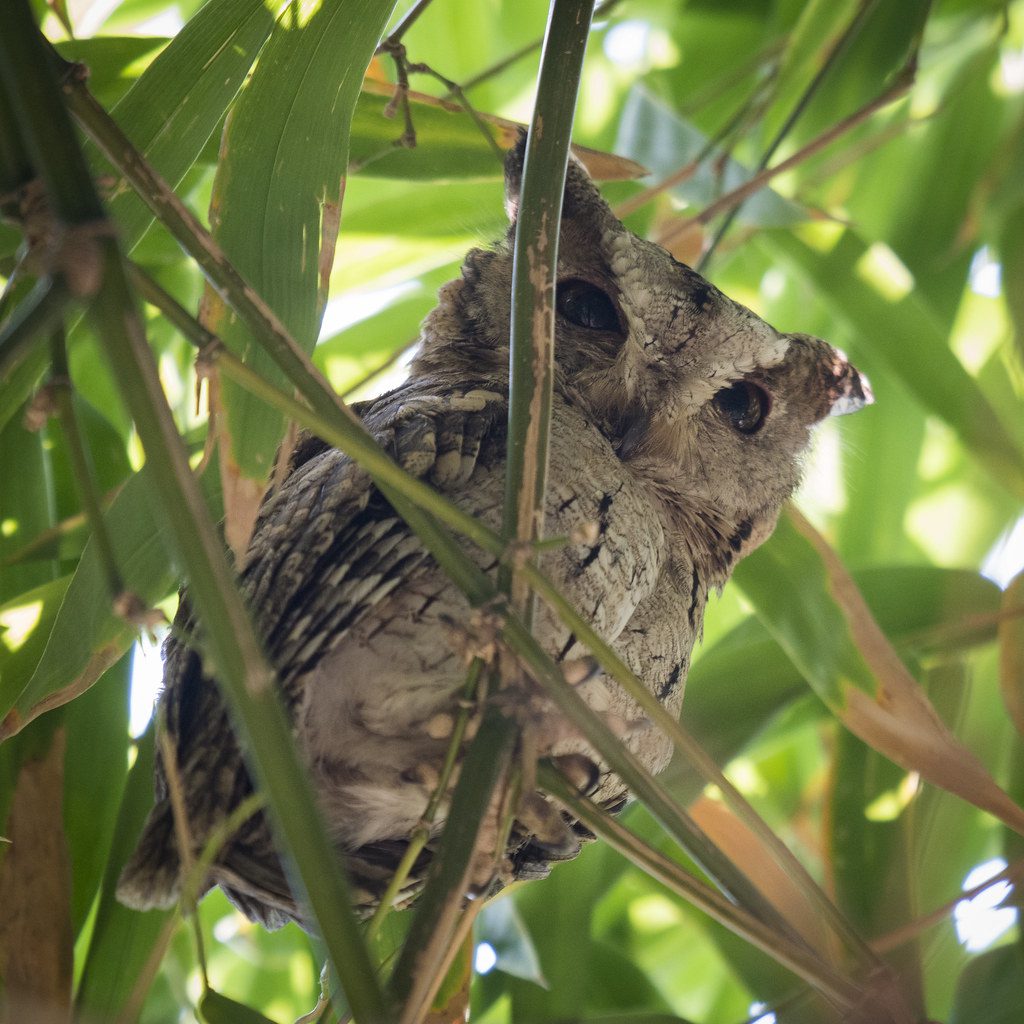
Behavior
Moving on from its reproduction and lifespan, the Indian Scops Owl exhibits a range of behaviors. Primarily nocturnal in nature, these birds spend their nights in search of prey such as small rodents, lizards, or insects. In terms of parental care, both parents will typically take part in nesting activities and caring for the young owls until they are able to fend for themselves.
Regarding territoriality, the male owl will defend his territory by vocalizing loudly during the breeding season and at other times when feeling threatened by intruders. Additionally, they may also perform aerial displays while calling out with distinctive hoots to establish their dominance over an area. These calls can be heard up to 2 miles away!
The Indian Scops Owls have also been observed engaging in some social behaviors; however, this is not very common among them due to their solitary lifestyle. They do sometimes gather together in groups known as parliaments but rarely stay beyond a few hours before going off alone once again. During these occasions, though, they use various vocalizations like whistles and trills used for communication with one another.
Overall, the behavior of the Indian Scops Owl consists mostly of nocturnal activity along with defending territories through vocalizations and occasional social interactions when gathering into parliaments – displaying how important language is even amongst wild animals!
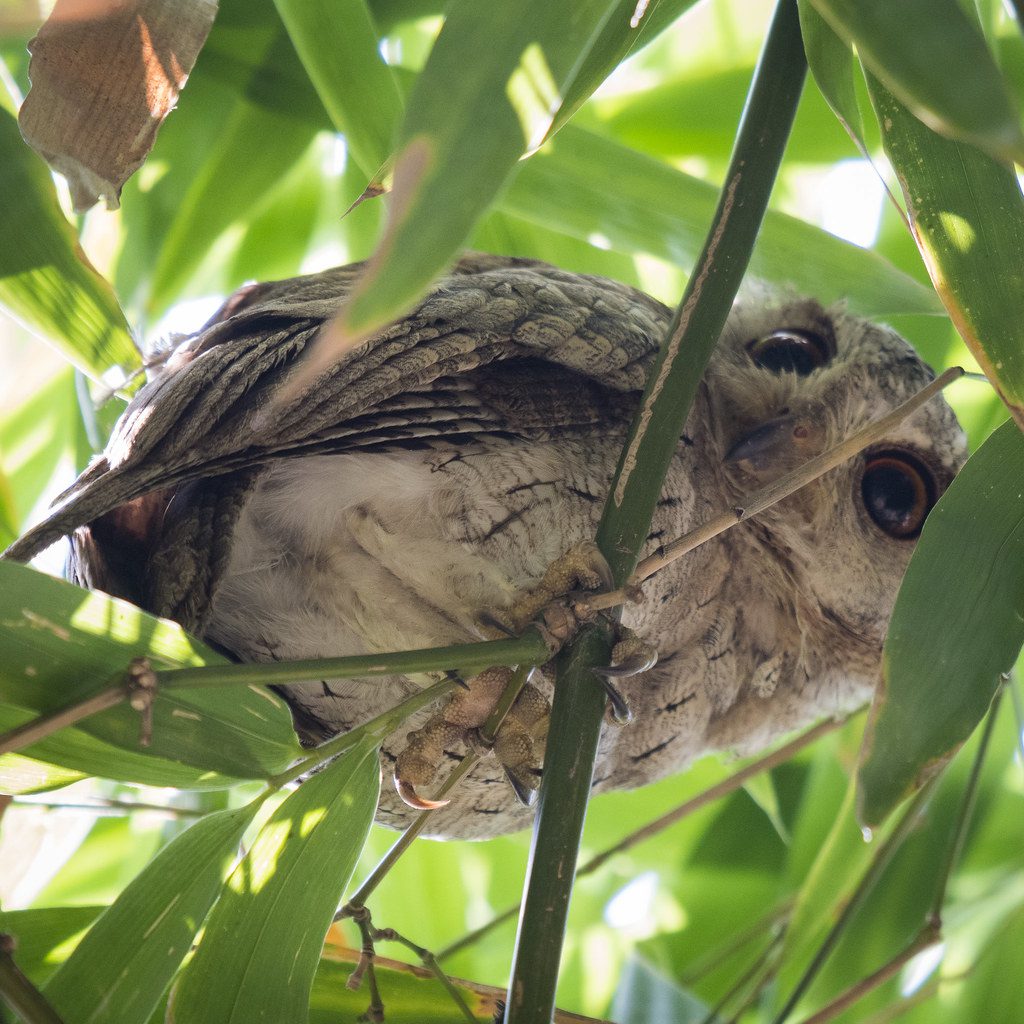
Interaction With Humans
The Indian Scops owl has a unique relationship with humans. There is evidence to suggest that these birds have been living in close proximity to people for centuries and even feature prominently in local mythology and folklore. For example, it’s believed that the owls offer protection against evil spirits and bring good luck during harvest time.
Farmers in some rural areas of India take owlets home as pets due to their endearing appearance and gentle nature. They are also kept around fields as pest control – the presence of an owl will deter other animals from entering the area or stealing food crops. This mutually beneficial relationship generates a sense of mutual respect between human beings and wildlife which should be celebrated.
Human influence can impact how Indian Scops Owls interact with one another in certain environments; they may become less territorial when there is more activity around them because they feel safer within groups rather than alone. Furthermore, cultural beliefs surrounding these creatures mean that many rural communities take great care not to disturb nests or eggs found near farms or homes out of reverence for this species.
It’s clear then that both birdlife and people benefit from having such a strong bond – understanding each others’ needs leads us to develop better practices for conservation in order to protect our environment together. In turn, this helps ensure future generations can enjoy the company of these beautiful birds without any risk of disrupting their natural habitats.
Conservation Status
The Indian Scops Owl is an endangered species, and conservation efforts are desperately needed to ensure its survival. With a population estimated at fewer than 10,000 individuals across India, Bangladesh, Nepal, Pakistan, and Sri Lanka, this small owl faces many challenges in the wild.
To understand the current status of this species, we must look closely at the threats it faces from human activity. The following table illustrates some of these:
| Threats | Impact | Solutions |
|---|---|---|
| Deforestation | Loss of habitat | Planting trees & shrubs |
| Pesticide use | Contamination | Restriction on use |
| Hunting/Trapping | Population loss | Legal protection |
| Urbanization | Habitat change | Creation of reserves |
In addition to direct human impact, wider environmental issues can cause secondary damage, such as climate change, which could further reduce available food sources or geographical changes affecting migratory patterns. All of these things combined make for very challenging times ahead if we want to protect the future of this unique bird.
Conservationists need to increase their knowledge base by researching local populations and developing strategies that meet both short and long-term needs while also allowing us all to appreciate and enjoy this species before it is too late. It’s clear that swift action needs to be taken now so our children can marvel at the sight of the Indian Scops Owl gliding silently through the night sky for generations to come.
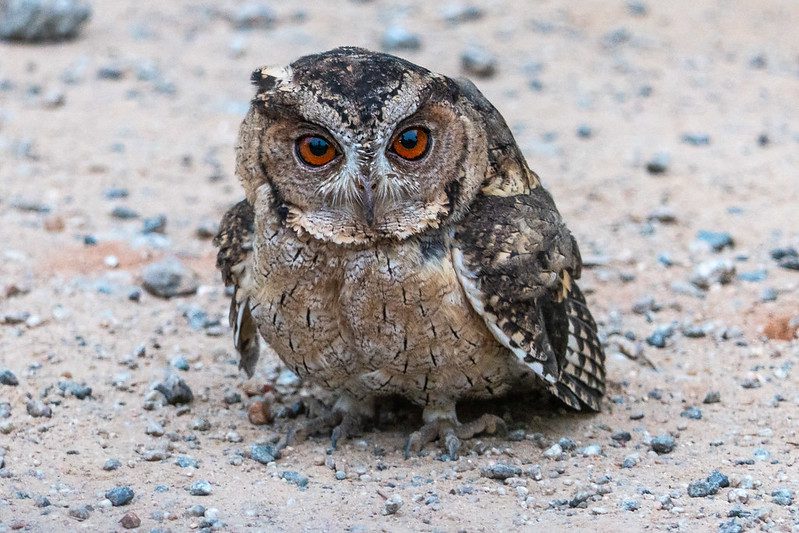
Cultural Significance
The Indian Scops Owl has been a part of Indian mythology, folk tales, and religious beliefs for centuries. It is seen as an important symbol of spiritual significance in many cultures throughout India.
Throughout Indian cultural symbolism, these owls are associated with wisdom, knowledge, wealth, and fertility. They have also been connected to the idea of being able to see through darkness – both physical and metaphorical. The presence of this species can be linked to protection from any misfortune or danger, which explains why they’re often found near temples and shrines.
In terms of practical applications, humans have always used these birds for pest control since their diet consists mainly of insects. Thanks to its nocturnal nature, people have come to rely on it in order to rid themselves of pests that would otherwise plague them at home or on farms.
Additionally:
- In some parts of India, the screech made by these owls was believed to ward off evil spirits.
- People also associated them with omens predicting good luck or bad news depending on how high in pitch the call was heard from within one’s vicinity.
- During festivals like Diwali, when firecrackers were lit up all over town, children would pray for the safety of their family members under the watchful eyes of these wise creatures flying around in search of food while providing a comforting sense of security against harm’s way.
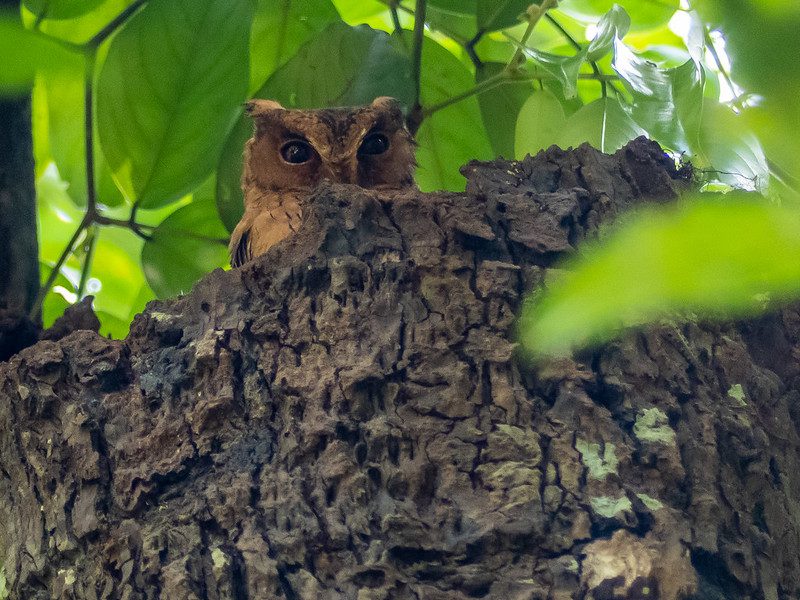
It’s clear that beyond having great ecological importance due to its role in controlling insect populations, the Indian scops owl has held deep spiritual meaning and served as a symbol with significant cultural relevance across several regions in India for generations now.
Identification Tips
Moving on from the cultural significance of Indian Scops Owls, let’s focus on how to identify them. The Indian Scops Owl is a small owl with a distinctive appearance and calls that set it apart from other owls within its range. It has an overall brownish-grey mantle, yellow eyes, and orange facial disks. Its long, narrow wings make it look slightly larger than other scoped owls when perched in trees.
The most obvious way to identify this species of owl is by its call, a single ‘hoot’ that can be heard at night or during early mornings near wooded areas. They have also been known to make whistling sounds which can be described as either shrill or mellow depending on their moods. These vocalizations usually occur right after sunset or just before sunrise but may vary according to the season and individual bird.
When looking for these birds while out in the wild, remember that they often prefer open spaces such as grasslands or agricultural fields rather than dense forests. Additionally, they hunt almost exclusively during twilight hours, so you should try searching during those times if possible. Regarding diet, they mostly eat insects like crickets and beetles, along with rodents or even small reptiles occasionally.
Indian Scops Owls can easily be spotted due to their distinct features and behavior patterns; however, always take extra precautions when venturing into any wildlife habitats and respecting the area around them. By following these tips, you’ll soon become familiar with this unique species of owl!
Adaptations
The Indian Scops Owl is a master of adaptation. Its nocturnal nature and camouflage keep it hidden from predators and prey during the day. As shown below, it has several physical adaptations that help it survive in its natural habitat.
| Physical Adaptation | Description |
|---|---|
| Hearing | Extremely sensitive ears which can locate prey |
| Vision | Large eyes with great night vision |
| Camouflage | Ability to blend into surroundings |
The most remarkable adaptation of this species is its hearing. By rotating their heads 270 degrees, they can pinpoint the exact location of small mammals scurrying through the underbrush with incredible accuracy. This helps them identify potential food sources quickly and efficiently while remaining concealed in their environment.
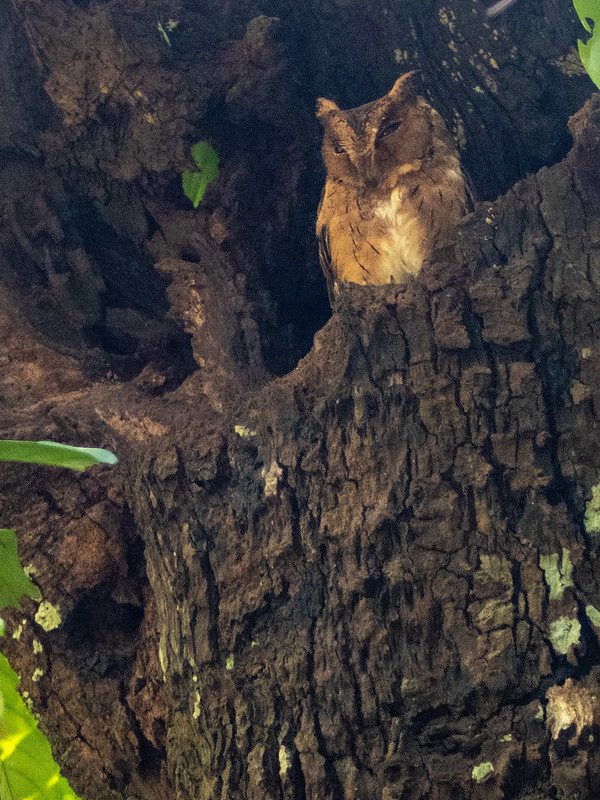
In addition to their excellent sense of hearing, Indian Scops Owls also have a very keen vision at night due to special photoreceptors in their retinas. They are able to spot movement even in complete darkness up to 100 feet away! The combination of superb hearing and sharp vision make these birds formidable hunters of the night sky.
Their ability to effectively use camouflage further enhances their predatory skills by allowing them to hide within their environment unnoticed until it’s time for them to strike. With such specialized adaptations, there’s no wonder why Indian Scops Owls are formidable hunters who can easily survive in many habitats worldwide.
Interesting Facts
The Indian Scops owl, scientific name Otus bakkamoena, is a fascinating species of raptor. With its unique plumage and lively behavior, this bird continues to captivate audiences around the world. Here are some interesting facts about it:
Behavior
- The Indian Scops Owl is an active nocturnal hunter which actively feeds on small mammals, reptiles, amphibians, and insects.
- It also has great vocal prowess with distinct territorial calls that can be heard from far distances in the night sky.
- They tend to form monogamous pairs during the breeding season and maintain close relationships throughout their lifetime.
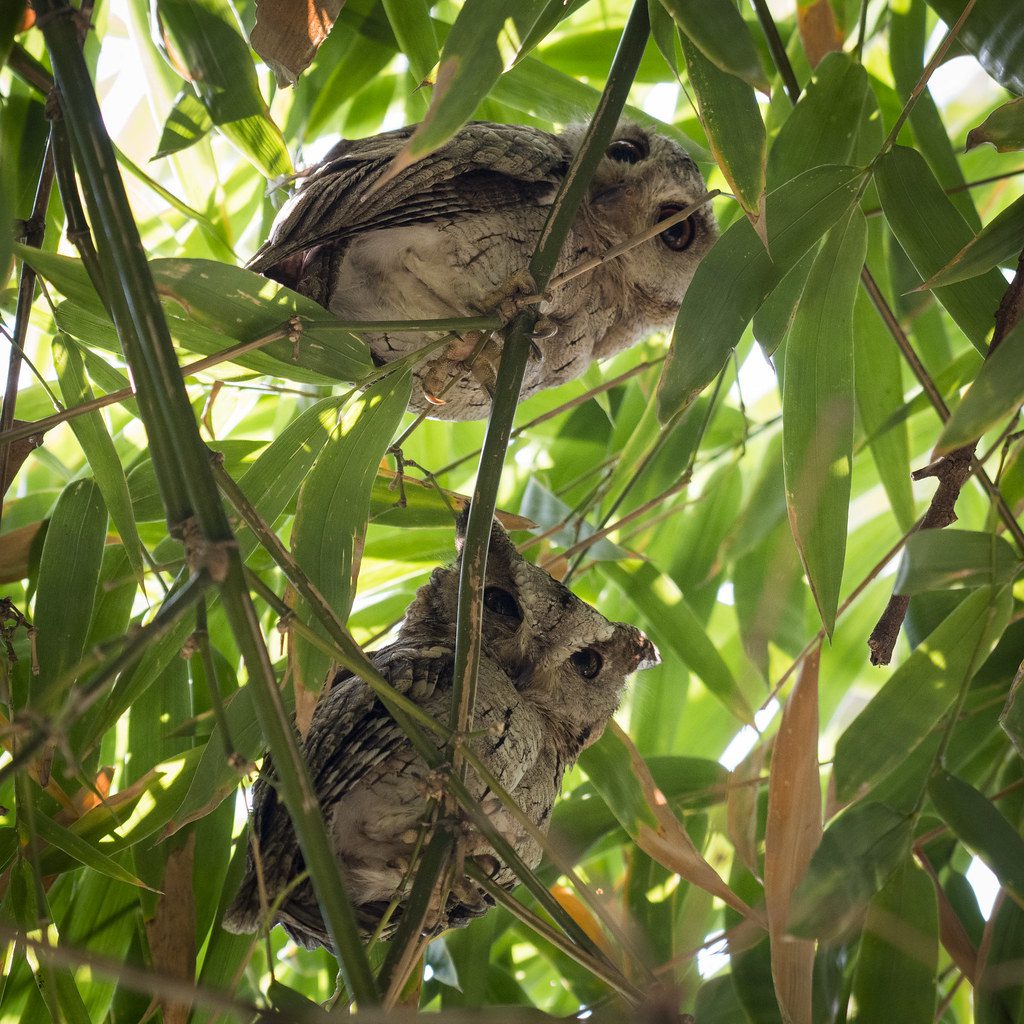
Lifespan
- These owls typically live in the wild for up to 10 years but may have longer lifespans when cared for in captivity.
- During their lifespan, they usually occupy one territory as they are known to be highly sedentary birds.
Adaptations
- An adaptation that helps these owls survive in their environment is their ability to camouflage themselves against tree bark or leaves using their feathers’ patterning and coloring. This allows them to remain hidden while hunting or avoiding predators like snakes or large birds of prey.
- As well as being excellent hunters, Indian Scops Owls possess strong defensive capabilities due to their talons and sharp beaks, capable of inflicting serious injuries even upon larger animals such as cats or dogs if disturbed too much.
Conservation efforts by various organizations have been taken up over recent decades to help protect these magnificent creatures from extinction due to habitat loss and other threats posed by human activities such as deforestation and poaching.
There has been a success so far, with sightings becoming more frequent across India, although much work remains left before we can consider them safe from further harm. Furthermore, educational programs continue to spread awareness amongst local communities regarding the importance of preserving wildlife habitats for us humans and our beloved animal friends who inhabit those areas alongside us all year round!
Similar Species
The Indian Scops Owl is not the only species in its genus. Many other scops-owls inhabit various regions of the world and share many similarities with it. The Burrowing Owl, for example, also has a distinctive facial disc like the Indian Scops Owl, although its eyes are golden rather than dark brown or black. Though found in different habitats, both birds tend to prefer open grasslands and arid deserts.
The Snowy Owl is another similar species that inhabit cold climates, such as in northern Europe and Asia. While they look quite different from the Indian Scops owl due to their white feathers and yellow eyes, they have similarly shaped wings, which allow them to fly swiftly through the air while hunting small prey. Likewise, the Long Eared Owl can be distinguished by its large ears and reddish-brown plumage, but its body structure is remarkably similar to that of an Indian Scops owl.
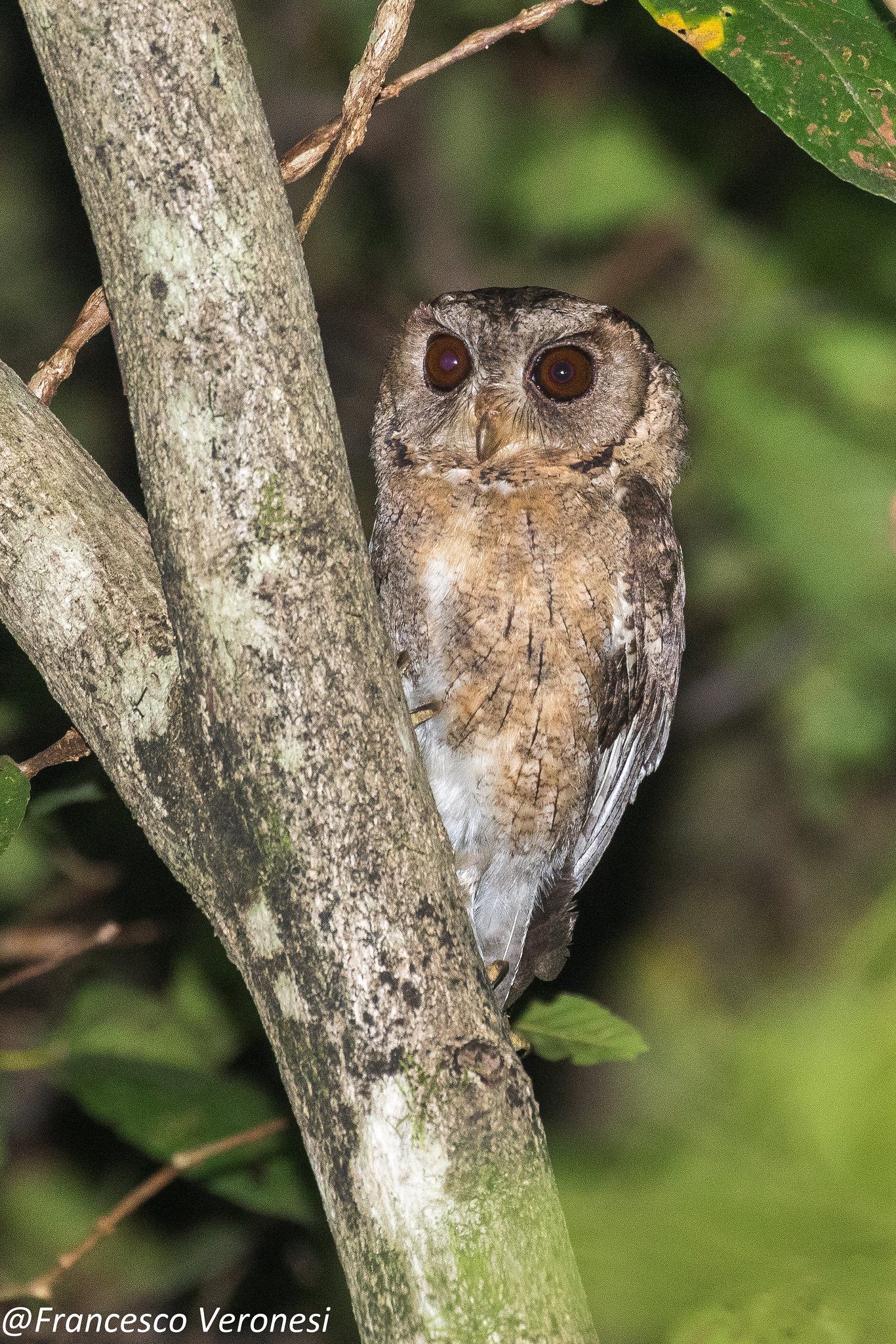
Finally, there’s the Great Horned Owl which shares some physical characteristics with the Indian Scops owl but differs significantly in terms of behavior. In contrast, most owls are solitary creatures. This particular species prefers living in pairs or family groups. All these owls exist side-by-side with one another around the world – each occupying a unique ecological niche within their local ecosystems.
Sightings In The Wild
The Indian Scops Owl is a species found throughout India and parts of Southeast Asia. It has been sighted in urban and rural areas, although it prefers to dwell in more densely forested regions. Sightings have also been noted in Bangladesh, Sri Lanka, Pakistan, and Nepal. In the following table, we can see the sightings of this owl across different countries:
| Country | Sightings |
|---|---|
| India | Common |
| Bangladesh | Occasional |
| Sri Lanka | Rare |
| Pakistan | Uncommon |
| Nepal | Occasional |
This small nocturnal bird is usually seen alone or in pairs during the breeding season but may form flocks outside of this period. The Indian Scops Owl makes its presence known by an unmistakable call similar to ‘tok-tok’ that can be heard at night.
Its diet consists mainly of insects such as moths, beetles, and crickets which are caught during flight or taken from the foliage on the ground after dark. They perform complex aerial displays involving dives, circles, and calls while flying through woodlands just before dawn to attract mates.
Despite being very common throughout India, many mysteries surrounding this elusive owl fascinate naturalists worldwide, making them highly sought after for research purposes. For these reasons, it remains one of the most iconic birds of South East Asia today.
Threats To Survival
The Indian Scops Owl is facing many threats to its survival. Habitat destruction, poaching, and human interference have all put this species at risk of extinction. In addition, climate change has become a major factor in the population decline of these owls, as their habitats are being destroyed by changes in temperature levels and weather patterns.
- Endangered Species: The Indian Scops Owl is endangered due to its decreasing numbers in the wild.
- Habitat Destruction: Human activity such as deforestation for agriculture or development purposes directly affects these birds’ habitats by destroying them. Additionally, changes in temperatures and weather patterns can cause secondary effects like desertification, which further reduces their available food sources.
- Poaching & Human Interference: Despite laws protecting wildlife, some individuals still engage in illegal activities like hunting or trapping that endanger the lives of these animals, leading to a decrease in their overall numbers. Furthermore, pollution caused by humans can also be detrimental to their health as chemicals found in runoff water may contaminate plants they feed on or even accumulate inside their bodies if consumed via the consumption of contaminated prey species.
The challenges faced by the Indian Scops Owl are numerous, but there is hope yet; with conservation efforts and increased awareness among citizens, we may be able to save this beautiful species from disappearing forever. It’s up to us whether future generations will get a chance to witness these majestic creatures living free in nature – let’s ensure they do!
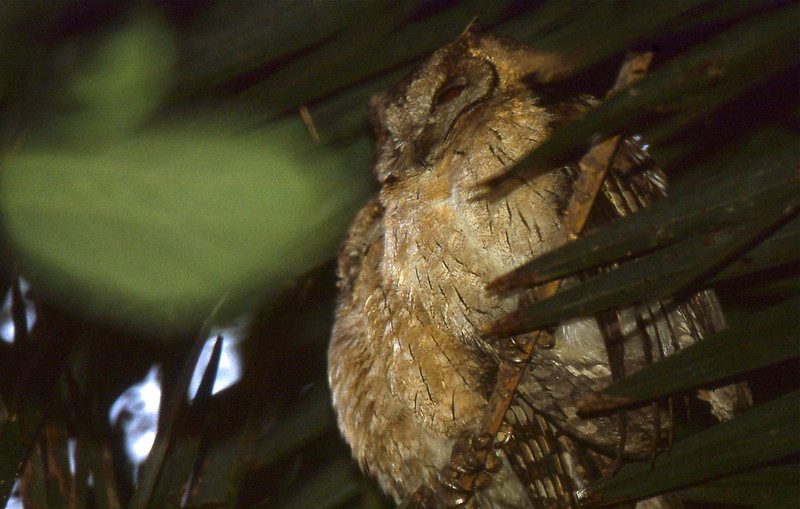
Frequently Asked Questions
What Is The Average Lifespan Of An Indian Scops Owl?
The average lifespan of a wild bird is an integral part of understanding its survival rate and breeding cycle. By examining the life history of any creature, we can discover more about their diet habits, social behavior, and overall habitat needs. When it comes to the Indian Scops Owl, this knowledge is essential in order to understand how they have been able to thrive in such diverse habitats throughout India.
When researching the Indian Scops Owl’s life history, one quickly discovers that these birds have an average lifespan ranging from seven to ten years. This is quite long compared to other family members, like the Short-Eared Owls, who only live around three or four years on average. In addition to having longer lifespans than some relatives, the Indian Scops Owl has adapted well to living in agricultural areas, forests, and wetlands; this helps them survive despite changes in land use over time.
This species’ ability to adapt gives us insight into their diet habits and social behaviors. They are largely insectivorous but will take small mammals during certain seasons if necessary for food. They build nests near trees or tall shrubs, laying eggs from April through June each year before beginning another breeding cycle soon thereafter. Their increased survivability lies in their longevity and their adaptive nature; being flexible enough to live among humans while still surviving off mostly insects shows remarkable resilience!
Unraveling the mysteries behind a species often reveals much about our connection to nature and what steps we should take as stewards of our environment. The story of the Indian Scops Owl demonstrates how even small creatures can make big differences if given half a chance — which is why ensuring their protection remains so important today!
How Can I Attract Indian Scops Owls To My Backyard?
Attracting birds to our backyard is something that many of us have dreamed about. But how can we make this dream a reality? Indian scops owls are one species of bird that may be willing to call your backyard home, but it takes some work and dedication on the part of the homeowner.
Creating an ideal habitat for any wildlife requires a combination of elements such as food sources, water sources, and nesting sites. For Indian scops owls in particular, providing them with ample perching areas and owl nesting boxes will allow them to set up shop nearby. The best way to get started is by doing research into what types of plants they prefer and what other birding supplies you might need to attract these magnificent creatures.
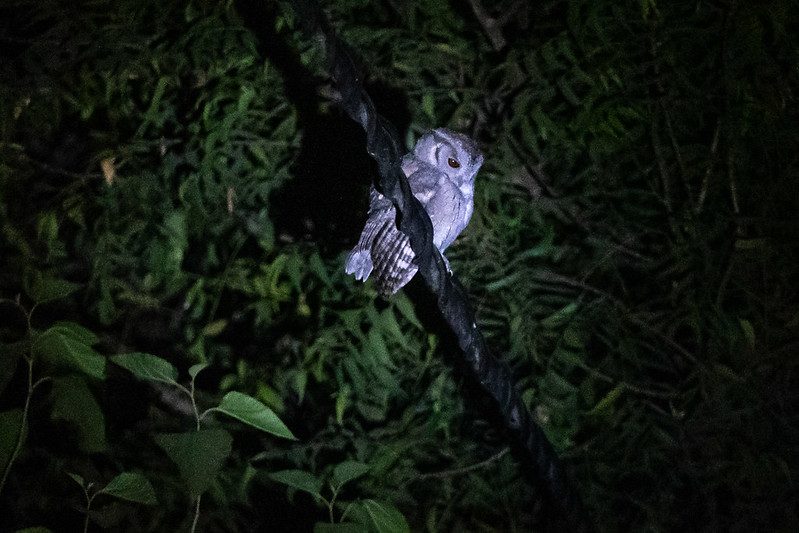
Once you’ve done all the necessary preparations, sit back and wait – if your backyard has created an inviting space for Indian scops owls, then there’s a good chance they’ll come! Of course, patience is key here; depending on their migratory patterns, it could take weeks to months before they decide to pay you a visit.
So if you’re looking for a rewarding experience that brings nature closer than ever before – look no further than creating an inviting atmosphere for Indian scops owls in your own backyard! With enough preparation and perseverance, soon enough, you’ll be able to enjoy watching these amazing birds fly overhead every now and again.
What Are The Main Threats To The Survival Of Indian Scops Owls?
The threats to the survival of any species are numerous and complex. The Indian scops owl, native to South Asia, is no exception. Habitat destruction, climate change, pesticide use, illegal hunting, and food scarcity all contribute to this majestic creature’s decline in population.
Habitat loss due to human development significantly impacts many species worldwide. For the Indian scops owl, it means that there is increasingly less space for them to live safely without fear of disturbance or predation by humans. These predators have also been known to hunt illegally for these owls, further threatening their existence in the wild.
Pesticides used in agriculture can seep into aquatic ecosystems where these animals feed and breed, leading to reproductive failure as well as other health issues such as increased susceptibility to diseases and parasites. Climate change has also caused alterations in temperature and rainfall patterns making certain areas unsuitable for habitation by these birds. This, combined with decreased availability of food sources, makes life even more difficult for them than before.
In order for us to ensure that the Indian scops owl remains an integral part of our ecosystem, we must take steps towards protecting its habitat from encroaching on human populations while simultaneously minimizing our negative impacts on its environment through thoughtful conservation efforts. With everyone’s help, we can create a better future where this bird will continue to thrive alongside us in harmony, much like they have since time immemorial.
Are Indian Scops Owls A Protected Species?
The question of whether Indian scops owls are a protected species is an important one for wildlife preservation. This species, which is native to India and parts of Sri Lanka, has seen its population decline in recent years due to human-caused threats such as habitat destruction and hunting. As a result, it’s essential that we understand the conservation status of these magnificent birds so that protections can be put in place to help preserve them.
When discussing the legal protection of Indian scops owls, there are several points to consider:
- Conservation Status: The IUCN Red List currently lists this species as ‘Least Concern.’ However, given the importance of protecting all species, it is still essential to discuss the legal protection of Indian scops owls.
- In India, the Indian scops owl is protected under the Wildlife Protection Act of 1972. It is illegal to hunt, kill, or capture the Indian scops owl without a permit from the state government’s Chief Wildlife Warden.
- It is also illegal to trade in any part of the bird, including its feathers, eggs, and nests.
- Additionally, the Indian scops owl is included in Appendix II of the Convention on International Trade in Endangered Species of Wild Fauna and Flora (CITES). This listing means that any trade in Indian scops owls or their parts requires CITES permits, and such trade must not be detrimental to the species’ survival in the wild.
Overall, the legal protection afforded to the Indian scops owl under national and international regulations highlights the importance of conserving this species and its habitat.









































